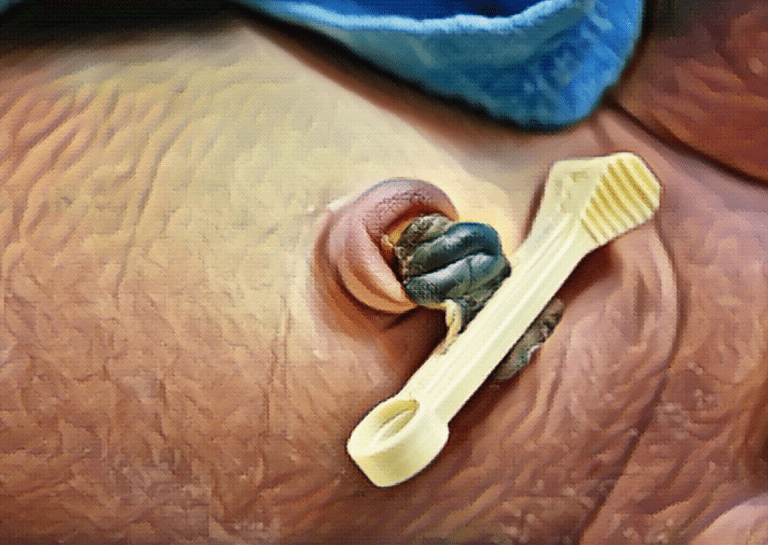In the womb, the umbilical cord acts as a supply line from the placenta to provide the baby with food and oxygen. Once the baby is born and the umbilical cord is cut, a small stump will remain in your baby’s belly button for around two weeks before it dries up and falls off naturally.
The umbilical cord stump requires proper hygiene and care in a couple of first weeks to prevent infection. Keeping the umbilical stump clean and dry and exposing it to fresh air will help it to separate and fall off on its own.
Here’s how to properly care for your newborn’s umbilical stump, what to avoid, and when you might want to see a doctor.
Umbilical cord care
The umbilical cord stump should dry up and fall off one or two weeks after birth. Until it falls off, the stump should be monitored and kept clean and dry to prevent infection.
Keep it dry
The stump must be kept dry and exposed to fresh air to assist the natural separation process and to prevent infection.
Let it happen
The stump should fall off naturally in due time, so do not try to pull it off yourself.
What to avoid
Rubbing alcohol
Although it may seem wise to sterilize the stump with rubbing alcohol, doing so can actually kill the natural bacteria that help the stump fall off on its own. Using sterilizing fluids like alcohol or chlorhexidine can prolong the separation process which can potentially increase the risk of infection.
Bathwater
It is important that the umbilical stump is kept dry to prevent infection and to help the separation process. When bathing your newborn, avoid submerging the stump in water and instead use a sponge to clean around the area.
Covering up
Exposing the stump to fresh air will help speed up the drying process, so avoid covering it with a diaper. Keeping the stump covered by the top of the diaper may also increase the risk of infection as it may be exposed to harmful bacteria.
When to see a doctor
With proper care and monitoring of the umbilical stump, it is rare for problems to arise. But if something isn’t right, it’s important to seek medical advice. Make an appointment with the doctor if:
- There is oozing or discharge from the stump.
- The stump doesn’t fall off on its own after three weeks. This is called delayed cord separation and can indicate an underlying problem such as immunodeficiency or infection.
- There is redness and swelling around the stump.
Omphalitis
Bacterial infection of the umbilical cord is called omphalitis. It can appear around three days after birth. Omphalitis is a very rare condition, thanks to sterile delivery practices and infection prevention procedures in hospitals.
However, there is still a risk of infection for the first couple of weeks while the stump dries up and the skin heals underneath. Infection can occur if the stump is exposed to harmful bacteria, so ensuring it is not treated with rubbing alcohol and letting it get plenty of fresh air will help prevent bacterial infection.
Symptoms of omphalitis
- Redness, swelling, or bumps around the navel
- Foul-smelling discharge
- Fever
- Lethargy
- Bleeding on or around the stump
- Odor from the area around the stump
- Reduced appetite
- Change in sleep patterns
See a doctor immediately if you suspect an infection. If a doctor confirms that there is an infection, they may prescribe an antibiotic and keep the baby in the hospital for observation.
Aftercare
Once the stump dries up and falls off after one or two weeks, you should continue to keep the navel clean and dry. The skin underneath should be healed but will still need to be kept clean and dry. It is not unusual for there to be minimal discharge after the stump becomes separated. Simply wipe it away with a clean cotton swab and allow it to dry with exposure to fresh air.
References
Gras-Le Guen C, Caille A, Launay E, Boscher C, Godon N, Savagner C, Descombes E, Gremmo-Feger G, Pladys P, Saillant D, Legrand A, Caillon J, Barbarot S, Roze JC, Giraudeau B. Dry Care Versus Antiseptics for Umbilical Cord Care: A Cluster Randomized Trial. Pediatrics. 2017 Jan;139(1):e20161857. doi: 10.1542/peds.2016-1857. PMID: 28008096.
McKenna H, Johnson D. Bacteria in neonatal omphalitis. Pathology. 1977 Apr;9(2):111-3. doi: 10.3109/00313027709085248. PMID: 876687.
Wilson CB, Ochs HD, Almquist J, Dassel S, Mauseth R, Ochs UH. When is umbilical cord separation delayed? J Pediatr. 1985 Aug;107(2):292-4. doi: 10.1016/s0022-3476(85)80154-2. PMID: 4020558.
